Final report for FNC21-1306
Project Information
Our 200 goats travel in a six-county area along the St. Croix River in Minnesota and Wisconsin. Our purpose is to limit the spread of invasive plant species through targeted grazing. We are contracted for services by municipalities, government agencies, associations, and homeowners. The average site is two acres and we have completed as many as 40 acres with one contract. The goats typically graze more than 100 acres in a season, from mid May to mid October. Prior to using virtual fencing, the goats were contained by portable energized net fencing, which is the standard for rotational graziers and targeted grazing operations.
Throughout our seven year history, our emphasis has always been on utilizing the most current technologies. Our fences are powered with solar energizers, as well as solar produced on our farm. Although we like to demonstrate our understanding of all the current technologies, our work is fundamentally in mimicking the oldest ways of nature. We pair our work to restore native ecosystems with holistic goat management and utilize any modern technology that will help advance this mission.
A technology is available that can expand regenerative agriculture, help mitigate climate change, and increase food system resilience. The current tools lead to financial, physical, and quality of life sacrifices that significantly limit the biomimicry potential of the most natural management and movement of livestock. A virtual fence system can mimic herd movement as natural predators would with wildlife. A virtual boundary of any shape or size can be created on a map, allowing the user to customize the area in which the animals are contained. Graziers can give access to a new pasture from anywhere.
We tested key issues of labor, containment, and setting with virtual fence devices on 60 goats, one of the most challenging species from a containment perspective. During the course of the project there were five instances of fence breaches and of those, four were in portable net fencing paddocks.
Some recent articles suggest that virtual fencing is only effective some of the time, but we did not find this to be accurate in our research. Virtual fencing is equally as effective as net fencing for containing goats. If an individual goat escapes from virtual fencing it is more likely to and able to return to the herd on its own. And importantly, when this occurs, usually the farmer does not have to take action and the situation is usually resolved in minutes.
When we analyzed all paddocks, virtual fencing required an average of 146.6 minutes less labor time per paddock than electronet fencing (p = 0.0002). This is not only for the initial set up but for all fencing related time logs while the goats were in the paddock. We found varying terrain and weather had no impact on efficacy of containment.
When the technology is established it replaces physical fences, reduces labor, and leads to revolutionary advances in rotational grazing, targeted grazing, silvopasture, firebreaks, and improved soil retention and water quality on non-arable land.
3. Record time and labor associated with virtual fences and portable net fences.
Cooperators
- (Researcher)
Research
Most people associate virtual fencing with invisible fences for dogs. Although there are virtual fence technologies for dogs, the most common systems of wireless dog containment are not the same as virtual fences. Virtual fences require no wires to be put in the ground, but rather, rely on GPS and cellular networks, meaning that the system operates anywhere in the country.
Nofence is a company that offers virtual fencing for cattle, sheep, and goats. Their system is designed to provide a humane and effective way to contain livestock within a certain area without the need for physical fencing. We chose Nofence for this study because they have the only commercially available collar designed specifically for goats. Additionally their technology has been chosen most by other research studies, likely due to their longevity and advanced status in the market. More than 3,200 farms use Nofence around the world.
The Nofence system has two components. The first is a collar that the animal wears, which consists of a rubber strap, metal chain, and a unit housing the battery, with two solar panels on the sides to help maintain the battery. The battery is also removable and rechargeable. The second component is a mobile application for phone or tablet. The main functions of the mobile application are to set the desired boundaries, record animal movements, and send alert notifications when a boundary has been breached. Each collar is displayed in the mobile application with individual animal identifications and any corresponding data such as number of warning sounds received, fence breaches, and battery levels. Unlike some other virtual fence systems, the Nofence system does not require setting up a base station tower at the property; instead it simply uses GPS and the cellular network. This makes the system usable for targeted grazing operations like ours that work at multiple property locations during a grazing season.
When an animal approaches the virtual boundary, the collar unit will emit a series of warning sounds that steadily increase in pitch. If the animal continues forward past the boundary, the device administers a three kilovolt electric pulse through the collar’s chain to deter the animal from crossing the boundary. The virtual fence system essentially functions the same as a physical electric fence. It simply replaces the sense of sight with the sense of hearing for the animal by substituting a visual barrier with an audible warning sound but using the same electric shock in both technologies to tell the animal to back away.
The 60 goats chosen from our farm to wear the Nofence collars were wethers over 1 year of age and non-lactating does. Goat kids under one year may not be suitable for collars. The breeds used were types of meat goats (Kiko, Boer, Nubian, and Myotonic). The goats were divided into study/treatment groups that used virtual fencing and control groups that used portable net fencing. The groups were chosen to include a comparable mixture of wethers and non-lactating does.
The primary locations for the research were at our targeted grazing sites, mainly private residential properties but also a few public areas. The sites had variable tree canopy cover, brush density, and were variable in terrain. We used a variety of paddock sizes in the study in order to test whether this affected animal containment, with the sizes of the paddocks ranging from 0.3 acre to a 25 acre paddock. The average paddock size was 2.4 acres. We utilized larger pasture paddocks to explore the viability of using virtual fencing with rotational grazing, wooded areas to test silvopasture applications, and smaller paddocks with increased stocking densities to test targeted grazing applications. Out of 35 total paddocks, 24 comparable virtual fencing paddocks and electronet fencing paddocks were paired with each other based on these factors: similar acreage sizes, similar terrains (such as wooded, prairie, steep-sloped, etc.), similar goat stocking densities, and type of property (private residential versus publicly accessible). In one case, the same residential paddock was grazed once with electronet fencing and once with virtual fencing, making a perfect comparison. It was important to pair similar paddocks for the purpose of comparing labor times, so we could analyze how long it took to fence a certain type of area, such as a one acre sloped wooded area for example, and how long it took to virtually fence the same type of area.
In calculating labor time, we did not record total labor time, but rather only the time spent on fencing/containment related activities. This included time spent setting up and taking down net fences and fence energizers, replacing batteries for fence energizers or for virtual fence collars, confirming virtual pasture areas uploaded to collars, and fixing any problems with physical or virtual fencing. Recorded labor time did not include time spent providing water, salt/mineral, or attending to any goat health issues since these activities are necessary for any group of goats regardless of the fencing.
We had to define what we consider to be an escape due to the new technology. We could not simply compare the number of times the app reported an escape versus the number of times we saw a goat outside the net fence. Since our study focuses on labor time, it made sense to define escapes as situations that required time and labor to remedy and ensure animal containment. What we did not consider an escape was a single goat reported as outside the pasture by the Nofence app, with a return to pasture notice within minutes, no damage occurred, and no action taken by the farmer. But what we did consider an escape was when net fencing was knocked down or damaged and action was taken to fix the fence, since escapes would be inevitable if no action were taken. An escape was defined by when we had to take action to prevent an escape and when an escape occurred.
For our goat training methodology, we followed the recommendation of Nofence and used an area with one virtual fence line going through a physically fenced area. We used an open flat pasture area for training, so we could easily observe the goats’ behaviors from a distance. We made a large rectangle with net fencing, and drew the virtual fence boundary on the app at about the halfway point of the rectangle. The remaining sides of the virtual fence boundary were assigned more than 100 feet extending beyond the net fencing, since we did not want the goats to come into contact with any of the other three virtual fence lines. When the goats approached the virtual fence line they did so at a normal pace. When the first goat to the line heard the noise, his head turned slowly and then his body turned around. Other goats nearby also heard the noise, either coming from his collar or their own, and they also turned back. All 30 goats were calm during this time, and we were surprised that they responded with the exact behavior we wanted without even receiving the shock. Over the next few hours the goats did start to learn that by ignoring the noise they would receive a shock, and they quickly learned to associate the noise with the shock. We were impressed by how few shocks the goats received overall in that first day, an average of less than two per goat.
In May 2022, after receiving 30 more virtual fence collars, we trained another group of goats. We used a large peninsula surrounded by a body of water, drawing the virtual fence line through the one side where land continued, so that the goats had three natural water boundaries and only one virtual fence boundary to learn. It is worth noting that Nofence did recommend a physical fence beyond the virtual fence during the training period, but we chose to not implement that for this area due to its land size and low risk of the goats being in an undesirable area. This allowed us to not put up any physical fences for this training. The time spent on this training session was 67 minutes, which included putting collars with batteries on the 30 goats, adding their identification information to the mobile application, and observing the goats’ behavior. Training continued throughout the month of May.
During the training periods in 2021 and 2022, we learned several important lessons. In 2021, as recounted in our SARE Progress Report, we learned that as they are learning and getting accustomed to virtual fencing, goats, especially hand-reared goats instead of dam-raised goats, are more susceptible to interference from people. We had two instances when a bottle raised goat decided to follow the landowner as he was jogging through their area and it led the herd to breach their virtual boundary.
We also learned the importance of fitting the collars properly on the goats. There should be just enough space to slide a flattened hand between the goat’s neck and the collar. If a collar is too loose, a goat can sometimes get its leg caught between its neck and the collar. If a goat is receiving an inordinate number of shocks compared to other goats, the collar is very likely too loose and the goat is not able to properly feel the electric pulse. When we tightened the collar, the problem was resolved. On the other hand, if a collar is too tight, problems can also occur. For instance the collar strap may start to tear. In one case, we found out the collar was too tight because the accelerometer inside the collar wasn’t triggered and we received a notification on our app that there was no movement detected for the goat. When we loosened the collar we did not see this notice again.
During training, we also learned that some consideration needs to be given for pasture design and how to bring goats into a virtual pasture. When creating a pasture area, we found that a pasture should not be too small, for instance less than 100 feet wide, or have buildings nearby that may interfere with GPS signals. We tried putting four wethers in an area that was approximately 300 square feet total with a building adjacent to the paddock, but the goats seemed stressed by the small space and one goat left the area. Regarding bringing goats into a pasture, we learned that it is best to release the goats into an area with distance from a simple boundary line, not near a corner or a boundary with a complex shape. It takes several minutes for them to get accustomed to a new area and to learn where the virtual boundaries are. If they are faced with a complicated set of boundary lines immediately they can panic. We made the mistake of releasing a group of goats into a corner of an area and it resulted in the goats receiving a high number of warning sounds and electric shocks and being confused and noticeably uncomfortable as they struggled to learn where the virtual lines were.
We also learned during training that all goats need to wear virtual fence collars to effectively contain the herd. We had one goat whose neck was too thick for the collar to fit properly and we had not yet received chain extensions from Nofence to fix the problem. So as an experiment at our farm, we tried not putting a collar on him while he remained in a group of goats with collars. We thought it was worth testing because he is not a herd leader and is a myotonic goat who walks slowly and faints often, so he didn’t seem likely to lead the other goats outside of their virtual pasture area. But we found that when he left the area, it led to other goats getting more frequent shocks and some goats following him beyond the virtual boundary.
We did not count these instances during the training period as escapes in our research since they resulted from our mistakes. With any new technology, there is a learning period for the farmer as well as the animals. Just as eight years ago when we were first learning to use net fencing, we made mistakes that resulted in goat escapes, such as having fences that sagged too much, had gaps or low voltage. We needed to learn best practices for pasture design and using the collars properly. Both we and our goats have many years of experience with electric net fencing, and so it’s not exactly fair to compare it with virtual fencing, without allowing for a training/learning period for the new technology. The ideal research study would be to use a farmer and goats with no experience with either electric net fencing or virtual fencing.
Overall, no relationship was testable between weather conditions or terrain differences and virtual fencing. Portable net fences are affected by weather in that wind, rain, snow and other weather events can alter the effectiveness of containment. The easiest example of this is a tree limb damaging a physical fence. It is generally accepted that adverse weather conditions can sometimes affect cell coverage negatively. This can lead to difficulty connecting to the network or slower data speeds. But in our research, we found that weather did not change the effectiveness of virtual fencing containment.
In general the accuracy of GPS is affected by terrain. A variety of factors, including the location and distribution of GPS satellites, elevation, and physical obstacles can affect GPS. One way that terrain can affect GPS accuracy is by blocking or reflecting the GPS signals. For example, if a GPS device is located in a valley or canyon, the surrounding hills and cliffs can block the GPS signals and reduce the accuracy of the system. Similarly, if a GPS device is located in an area with tall buildings or other structures, the signals can be reflected or scattered, which can also reduce the accuracy. Conversely, when a GPS device is at a higher elevation, it is more likely that it will have a clear line of sight to the GPS satellites, which will improve the accuracy of the system.
Although GPS can be affected by terrain, we did not find any significant effects in treatment paddocks. It did not affect our ability to trial at any location nor show different containment results. However, for best accuracy it is important for the user to know how best to use the system with terrain in mind by creating good pasture designs and extending virtual fence boundary lines beyond what the map looks like to account for hillsides. Current GPS technology has about a 16 foot variance in position accuracy. So if there is a particular area that is absolutely critical to keep livestock away from, then the virtual fence boundary line should be made with some distance to allow for GPS variance.
Out of 35 test paddocks, there were five escapes. One escape was at a virtual fence paddock, and four were at electronet fencing control paddocks. There were not enough containment breaches for a statistical analysis. Here are the circumstances of the escape incidents:
The escape at the virtual fence site involved the entire herd of 15 goats. The site was a university with a 2.5 acre paddock size. We theorize that children may have been involved in the escape incident, as there was a large group of school-age children at the university for a summer camp, but we were not present to witness the event. We were not able to obtain any detailed information so we can only speculate about the cause. We know that the goats left the area at an accelerated pace, and when they left their designated paddock, they immediately returned to their previous paddock area and stayed there. We reloaded the previously saved area from the app to the collars to contain the goats in this previous paddock. This was done on a mobile device, from home, within minutes of the fence breach because the Nofence app alerted us as the goats crossed the virtual boundary, and we could immediately adjust fence lines to provide alternative containment. The goats had been at this same public site for the previous 46 days with people present everyday without having any escape incidents. Later in the season, the goats returned to this site for 11 days with no containment breaches.
For comparison, the control site that was paired with the above-mentioned virtual fence site had two escape incidents with electronet fencing. The paddock was a 3 acre suburban public park. The first incident involved a single goat that was reported as being outside the fence. We went to the site, caught the goat, and put it back in the paddock. The net fence was inspected but no noticeable problem was found, so the cause of the escape was unknown, as we were not present and were unable to obtain information about it. The second escape incident at the site involved two panels of net fencing that were knocked down on the ground. The problem was reported to us by a park visitor and we were able to visit the site and fix the fence problem in time, but if action had not been taken, a goat escape would have occurred. The cause of the knocked down fence was unknown.
The next containment event also occurred at a suburban public park site, but with a paddock size of 2 acres. An incident occurred in which about 60 feet of net fencing was knocked down to the ground. Multiple fence wires were torn or damaged, so it was clear based on our previous experiences that a deer or multiple deer had run through the fence. The goats did not escape because the problem was reported to us by a park visitor and we were able to fix the fencing problem in time, but if action had not been taken, all goats in the paddock would have eventually escaped.
The final escape incident at a control site involved a single goat. The paddock was a 1.5 acre hilly, wooded area at a private residential property. When we arrived at the site, a single goat was standing outside of the electronet fence and trying to get back in to join the herd. We caught the goat and returned it to the paddock. We theorize that the goat jumped over the fence by jumping off of a plastic compost tumbler that was located near the fence, but the cause of the escape was uncertain as the fence was not disturbed. It is worth noting that had this same event happened at a virtual fence paddock, the goat would have been able to return to the herd on its own without any need for a farmer’s time or labor, since with Nofence, goats only receive electric shocks when leaving a virtual paddock, not when returning.
We examined labor differences between electronet fenced paddocks (control) and virtual fence paddocks (treatment). Labor was measured as minutes per site. Time differences can be counted as: 1) minutes per site, 2) minutes per goat, 3) minutes per acre, 4) minutes per day. In all cases, statistically significant differences were found. With all these four types of analysis and whether comparing paired sites or unpaired (total) sites, the labor times for the virtual fence were significantly less than for electronet fencing. The majority of labor time for control sites was spent setting up electronet fencing, with the labor time increasing in thickly wooded areas and on steep slopes. The majority of the labor time for treatment sites was spent drawing a map on the app, waiting for the map to load onto the collars (3-5 minutes), and maintenance checks for changing batteries, although the battery changes were infrequent overall.
Paired Site Results:
Most sites were designed as paired sets of control and treatment, and those were analyzed with a paired t-test.

1) Minutes per site: Average minutes per site differed by 190.8 minutes, with an average of 255 minutes needed for control sites versus 64 minutes for Nofence sites (p = 0.0003).
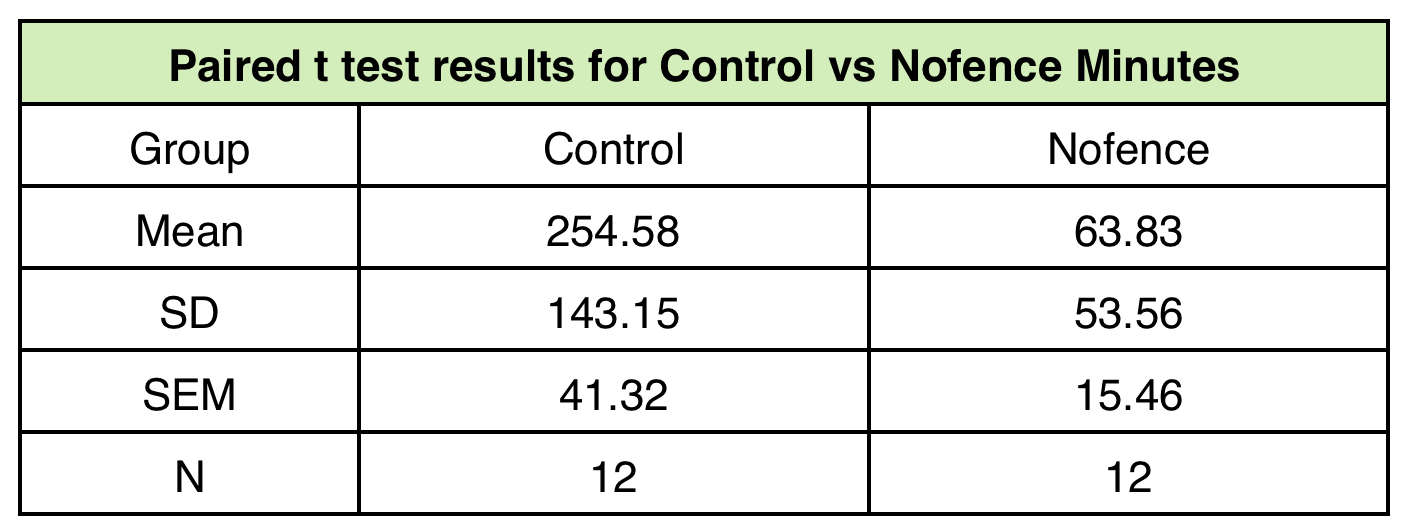
2) Minutes per goat: Average minutes per goat differed by 6.5 minutes, with an average of 9.6 minutes needed per goat for control sites versus 3.2 minutes per goat for Nofence sites (p = 0.0017). This time difference may seem small, but when multiplied by a large herd size, there was a significant time savings with virtual fencing.
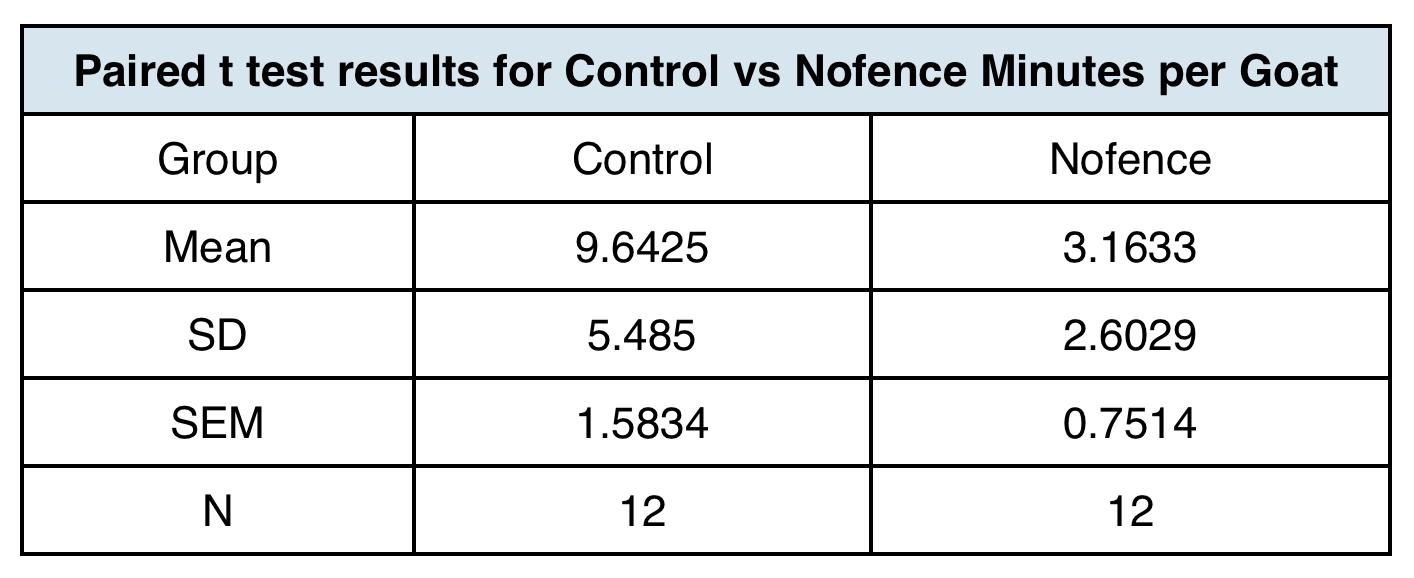
3) Minutes per acre: Average minutes per acre differed by 119.2 minutes, with an average of 163 minutes needed per acre for control sites versus 44 minutes per acre for Nofence sites (p < 0.0001).
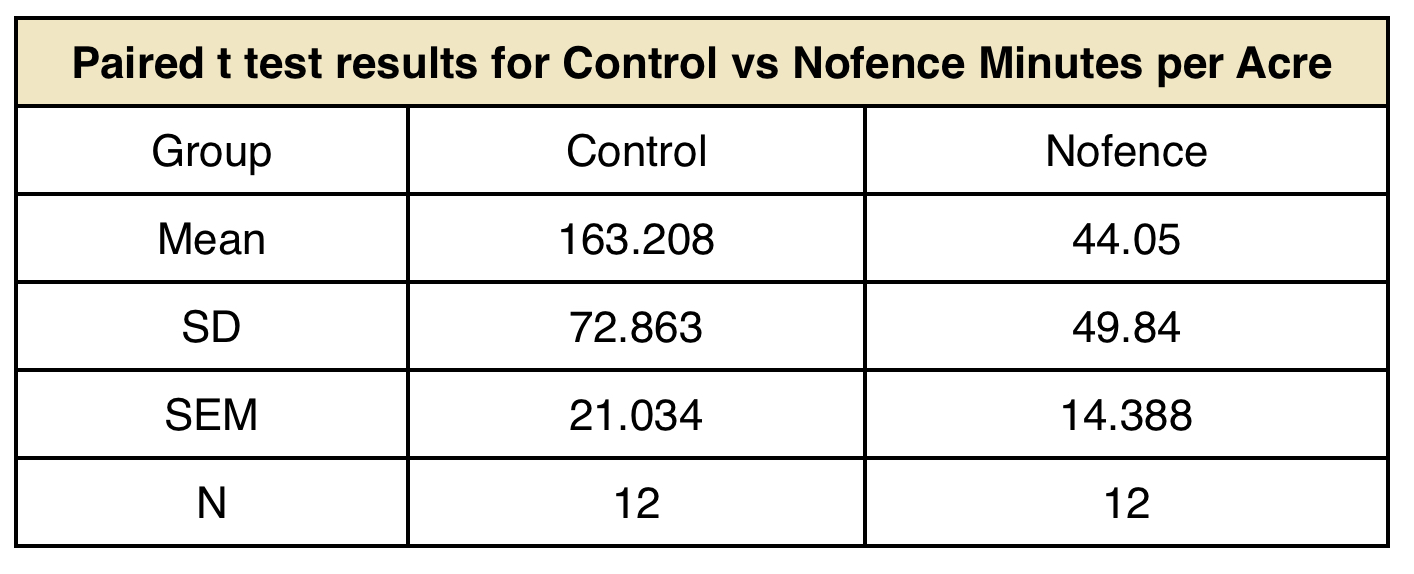
4) Minutes per day: Average minutes per day differed by 21.8 minutes, with an average of 26 minutes per day needed for control sites versus 4 minutes per day for Nofence sites (p = 0.0005).
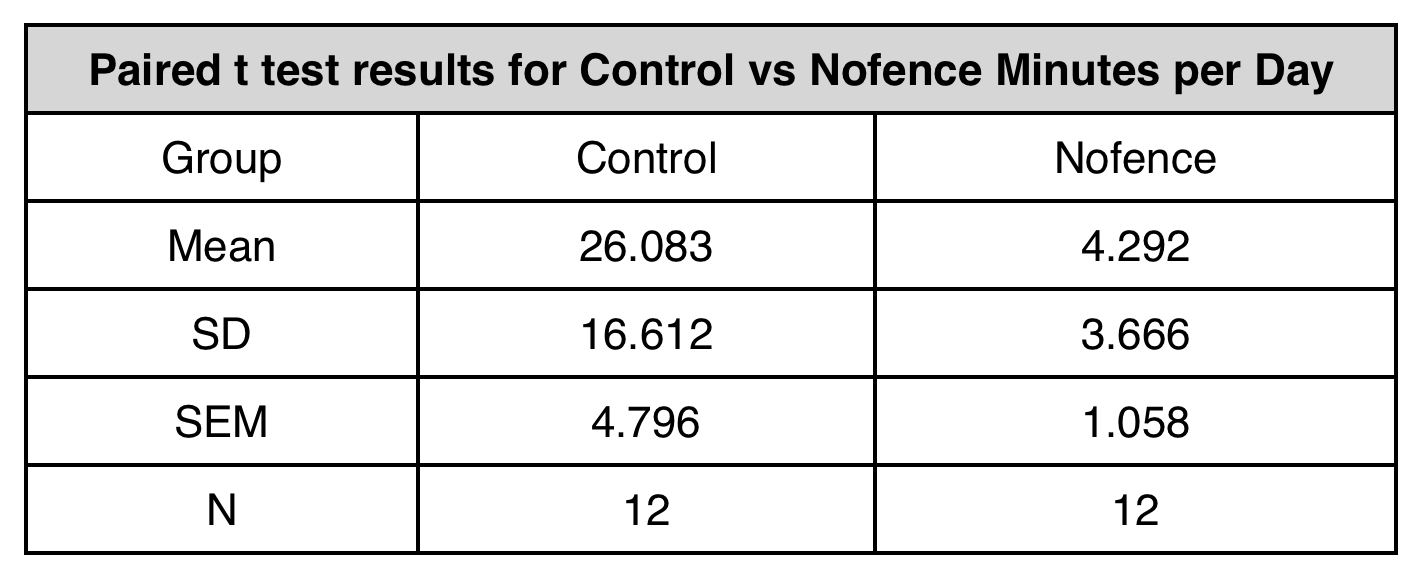
Unpaired Site Results:
There were additional sites in the two treatments that were not paired for analysis, so those were included in the total set of sites, for an unpaired t-test analysis.

1) Average minutes per site differed by 146.6 minutes, with an average of 204 minutes needed for control sites versus 57 minutes for Nofence sites (p = 0.0002).

2) Average minutes per goat differed by 6.2 minutes, with an average of 9.4 minutes per goat needed for control sites versus 3.2 minutes per goat for Nofence sites (p = 0.0005).
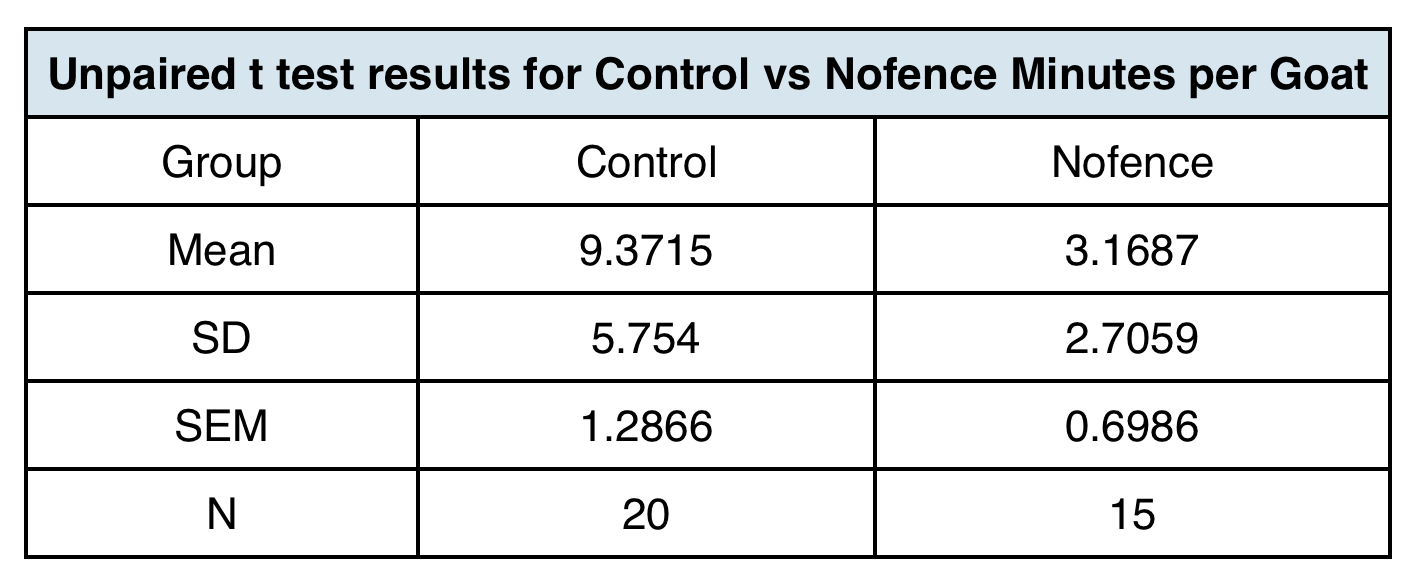
3) Average minutes per acre differed by 141.9 minutes, with an average of 179 minutes needed per acre for control sites versus 37 minutes per acre for Nofence sites (p < 0.0001).
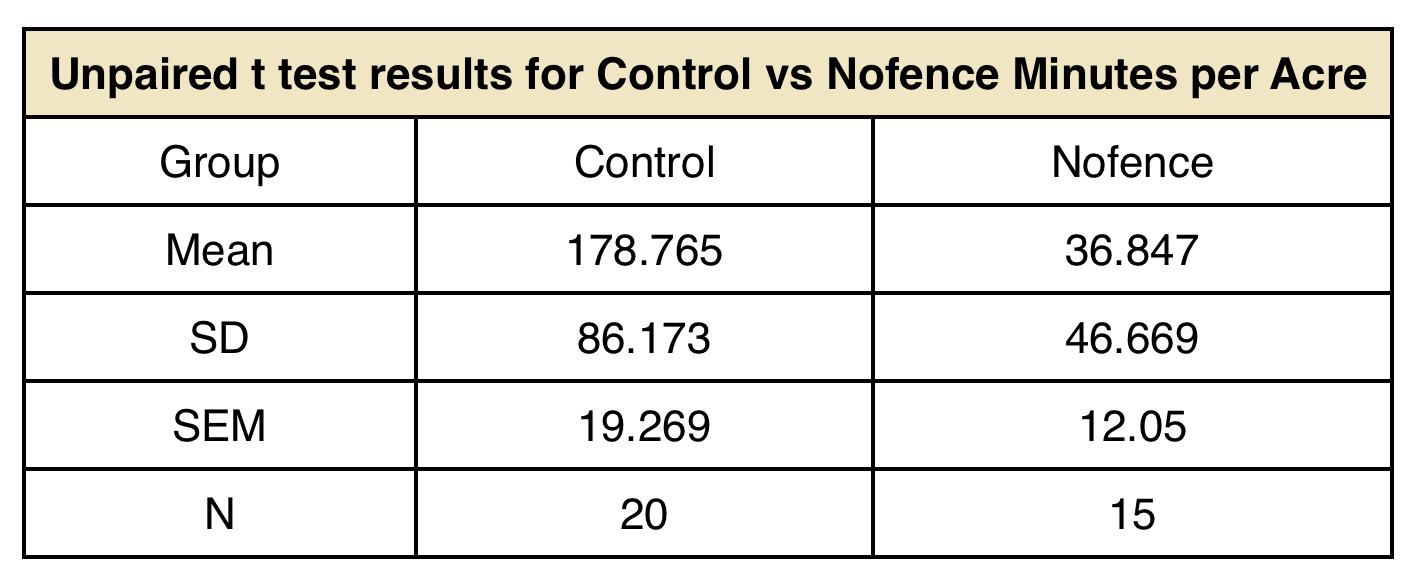
4) Average minutes per day differed by 18.1 minutes, with an average of 23 minutes per day needed for control sites versus 4 minutes per day for Nofence sites (p < 0.0001).
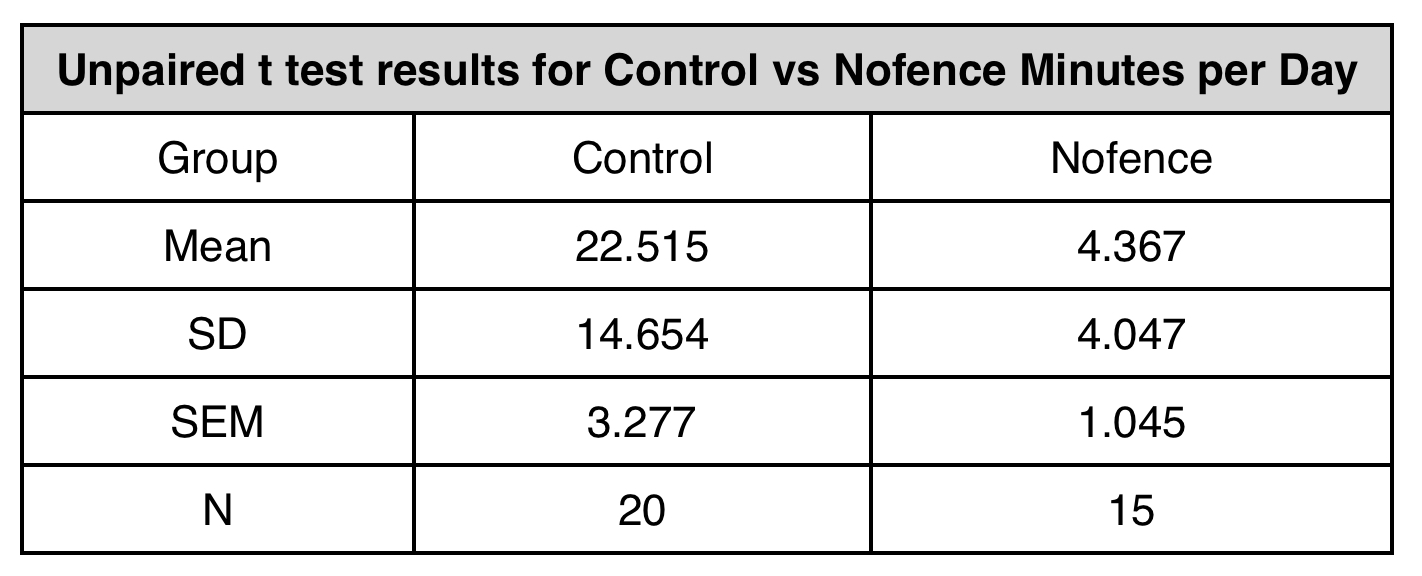
Other Results:
During the 17 months using virtual fencing there were some hypothesized situations that did not happen. For instance, we thought we would have to regularly put collars back on the goats. During the project there were two instances of collars falling off the goats. In both instances the collar fit improperly on the goat, and we learned that it was a tighter fit than it should have been. Our goats are nearly always in thick brush in woodland areas and so we found it impressive that for the entire duration of the project this was not a recurring event. Conversely, we never had an instance of a goat getting stuck in brush due to a collar.
Although not a focus of the study, there were no incidences of predation, including non-lethal encounters. This was interesting because the goats were at ten unique locations, including variance in urban density and in a 60 mile radius of our farm. This was true for both the control groups and the treatment groups. Specifically, in the treatment group where virtual fencing was being used, there was no perimeter or physical fencing at any of the locations.
Although we did not formally record time between battery changes, we found that the rechargeable batteries lasted between three weeks and three months, which is accurate to what Nofence claims. We assumed batteries would deplete at the same rate for all goats in a given group, but this was not the case. We generally replaced 1-3 batteries in a given replacement session. Since the batteries are removable we ordered extra batteries so that we could insert fully charged batteries onsite. Batteries generally needed to be changed more frequently during winter, but this is no different from net fencing since deep cycle batteries for fences will also deplete faster in colder weather. We did not compare the battery life between seasons in this study. This could be an area for further research. We used the collars in below freezing temperatures and they did not stop functioning or deplete the battery. The Nofence app makes battery changes easy because the location of the animal with a low collar battery is visible on the app, along with the ear tag, name or other identifying information about that animal.
Educational & Outreach Activities
Participation summary:
When a fence is not a fence (press article)
The Munch Bunch works to combat invasive species (press article)
| Date | Outreach Type | Description |
| December 2021 | Newsletter Article | Wrote an article for Hoofprints, a quarterly newsletter for members of the Cashmere Goat Association. One Small Step for Goat, One Giant Leap for Agriculture, Hoofprints, Volume 30, Issue 3. |
| January 17, 2022 | Farm Visit | Joined NoFence team at Voss Farm in Paynesville, MN to learn about Sherburne National Wildlife Refuge grazing project and answer questions about how virtual fencing may aid in project. |
| January 18, 2022 | Farm Visit | Leaders from NoFence visited our farm and we shared our project and how we are incorporating virtual fencing in our operation. |
| January 22, 2022 | Conference Presentation | Presented on virtual fencing project at the 30th Annual GrassWorks Grazing Conference. There were 37 attendees in the session. |
| May 22, 2022 | Education Event |
175 people attended event at Franconia Sculpture Park where four goats were in an area grazing. Explained our project and virtual fencing. |
| May 21, 2022 | Field Day | Hosted by Traditional & Green Skills, 8 farmers learned about Nofence while interacting with goats contained by virtual fence. |
| May 03, 2022 | Education Event | East Metro Water Resource Education Program and Washington County Parks hosted education event. Goats were contained by virtual fencing during the event. There were 75 participants. |
| September 09, 2022 | Field Day | Sustainable Farming Association sponsored field day. Presentation of virtual fencing and pasture walk to see goats with collars. There were 51 attendees. |
| December 06, 2022 | Podcast | Talked about Nofence on AgEmerge podcast #098. |
Learning Outcomes
Fences have always been a barrier of entry to farming, and even existing operations make fencing decisions based on accessibility or ease of installation. A virtual fence system is almost endless in opening new forms of revenue and improving quality of life. Removing the labor of traditional or portable fence systems allows season extension, better management of herd health, and reduces fence upkeep and replacement. In accessing terrains previously not possible, we can reduce the spread of invasive plant species and improve soil health. When goats are considered for a restoration project, it is often the case that machinery or other traditional options have been ruled out. When we cannot access areas with goats due to portable net fencing constraints, there are often no more remaining options and the vegetation has no natural biological control. Farms are restricted in growth by the cost of fencing and the cost of labor. With the virtual fence system operating on GPS, utilizing goats and specifically goat service operations is ideal because of the multitude of scenarios, terrains, and size areas we approach. We quickly saw how easy it was to create new areas of forage that were previously impractical due to fencing, time, or additional money.
There was a noticeable difference in how we responded to escapes with the two systems. When a goat escaped from traditional fencing we had no information other than what others reported to us or what we could see on site. The lack of information usually caused stress, as we scrambled to find out how many goats were loose, where the loose goats were, and how long they had been out, while also prioritizing finding issues in the fence and making fixes quickly to prevent further goat escapes. It was a different experience with virtual fencing due to the real time information available in the Nofence app. We knew immediately when a goat breached a boundary by an alert on our phones from the app. We could see their current position, even if escaped. We also had an alert when they rejoined the herd (there is no shock when crossing back into the paddock). We knew that no other goats had escaped based on their status and positions. Having this information led to far lower stress.
We saw a marked difference in our quality of life after implementing Nofence. In previous growing seasons, each day of the week was spent traveling to sites, setting up and tearing down fencing. Days without those activities were typically once a week or once every two weeks. For the 2022 season, we were consistently seeing three days a week not doing those activities. Only 60 of our 200 goats had Nofence collars and it still reduced the total amount of work significantly. We were also able to implement season extension and kept the goats in wooded areas until the middle of December. We otherwise would have started to feed hay due to the fast pace of moving fences through areas with limited vegetation. While portable net fencing may have its applications due to current limitations in virtual fence technology, we plan on managing all goats primarily with Nofence in the future. It may be, after all, the greatest invention in agriculture in our lifetime.
Project Outcomes
Nofence selected pilot farms to test their product in the US in 2022 and there were 23 goat and sheep farmers that implemented virtual fencing, many of which were targeted graziers. Many found our project through social media, our website, or the SARE website.